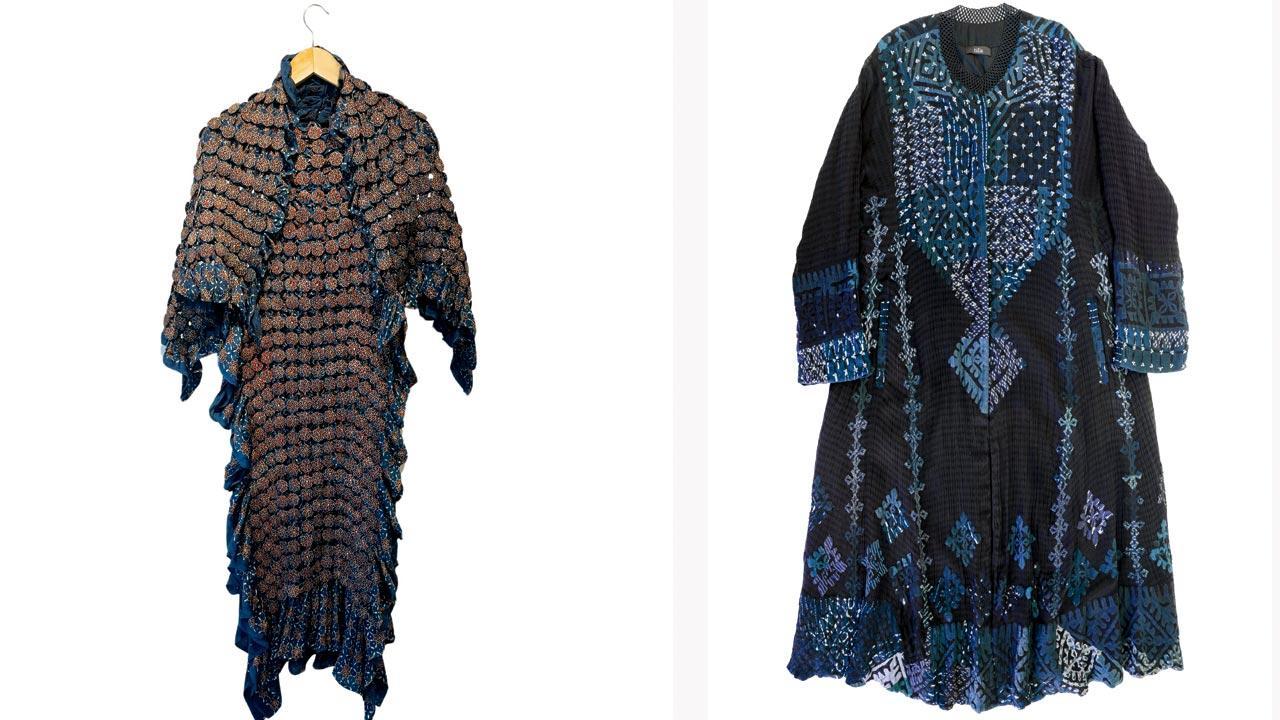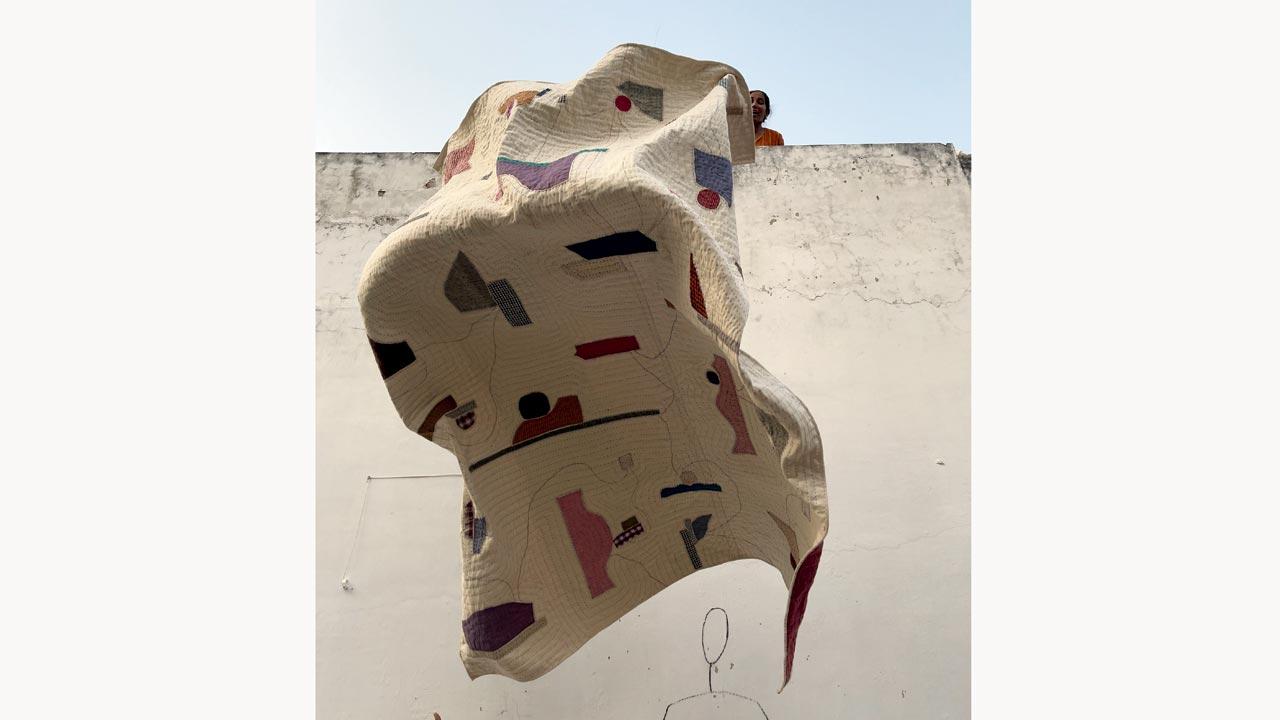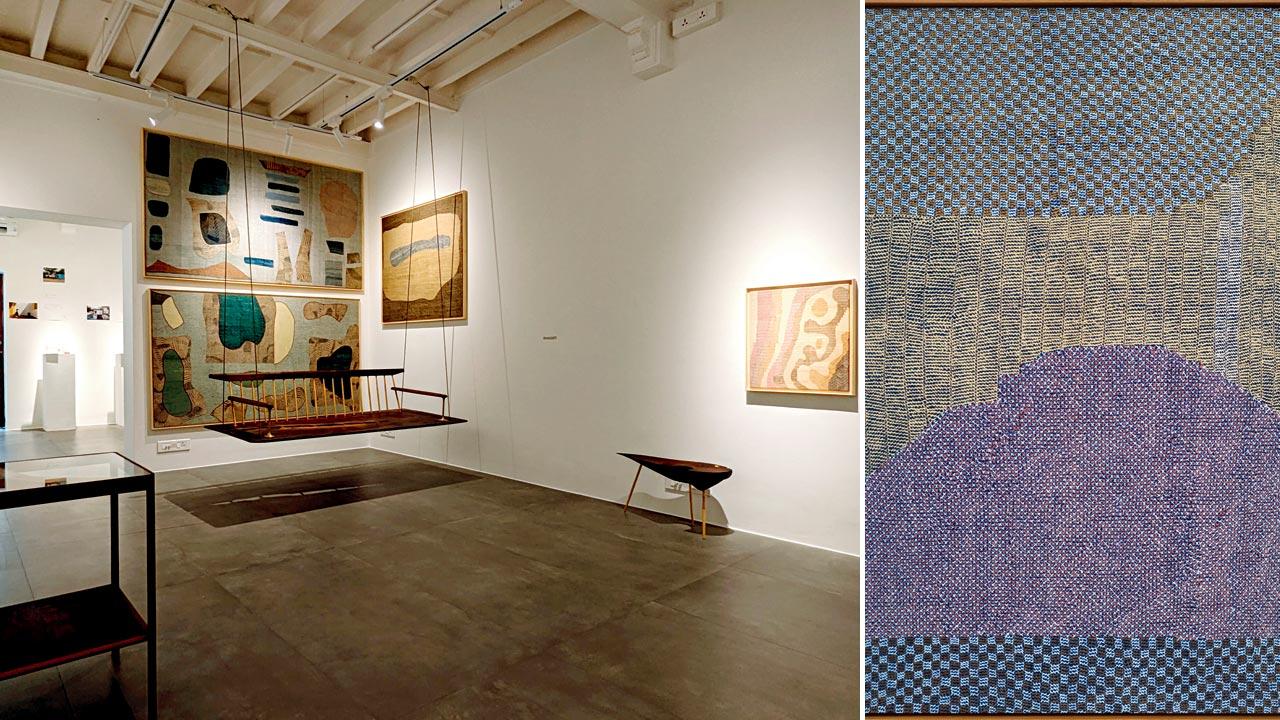Ahmedabad or Amdavad, famed for its modernist architecture, becomes the focus of a new design show that uncovers what makes the city a vibrant crucible for creativity, cultivating practices beyond the commercial mainstream

Anuj Sharma of Button Masala, in collaboration with Ajrakh artist Zubair Yousuf Luhar, created this low-tech dress using an inventive joinery technique with buttons and rubber-bands; (right) Inspired by Syrian coats from the Qalamoun region, this voluminous silk-cotton coat by Tilla is embellished with appliqué embroidery made from patches in shades of blue and black, recycled from production cutting waste
 Ahmedabad often calls to mind the cult of modernist architecture imagined by old masters like Le Corbusier, BV Doshi, Louis Kahn and Hasmukh C Patel. Even in their most austere concrete forms, their buildings exude candour and inventive imagination. It is with this sense of deliberate provocation that interior architect and curator Kunal Shah has titled his latest exhibition, Ahmedabad: Mecca of Design, on view until October 6 at 47/A, Khotachiwadi.
Ahmedabad often calls to mind the cult of modernist architecture imagined by old masters like Le Corbusier, BV Doshi, Louis Kahn and Hasmukh C Patel. Even in their most austere concrete forms, their buildings exude candour and inventive imagination. It is with this sense of deliberate provocation that interior architect and curator Kunal Shah has titled his latest exhibition, Ahmedabad: Mecca of Design, on view until October 6 at 47/A, Khotachiwadi.
Modernism thrives in Gujarat in a way that it doesn’t in Punjab, where Chandigarh stands as an anomaly. “The unique blend of Gujarati flair for modern aesthetic, Jain philosophy, and brutalism promote simplicity as the highest form of sophistication. However, the city’s rapid changes are eroding these design values and the contemplative lifestyle they once supported,” Shah thinks.
After his parents relocated from Bombay, Shah spent more than two decades in Gujarat. He says, “Growing up in Bombay, you take many things for granted. Moving to Gujarat was a leveller, forcing me to engage with diverse perspectives I hadn’t known. Despite being Gujarati, I was thinking and speaking in English among Gujaratis conversing in Gujarati.”
 Stepping into the Raasleela room reveals a tangled web of artistic threads and pillowy fabric orbs, broadening up perspectives on: what is applied and contemporary art?
Stepping into the Raasleela room reveals a tangled web of artistic threads and pillowy fabric orbs, broadening up perspectives on: what is applied and contemporary art?
He admits to having a complicated relationship with Ahmedabad, Gujarat’s capital. “I am a non-veg Gujarati. I was there during the 2002 riots, and have seen the dark side. I now engage and interpret it on my own terms.”
More than just a period style, Shah’s modernism resembles a secular religion, with its sacred tenets of inclusion, community and sustainability interlaced into a group show featuring artists and designers across a medley of mediums and methods, including furniture, sculpture, paintings, buildings, printmaking, photographs, textile clothing, artworks and upholstery. “For me, that utopia—the dream of modernism—persists in Gujarat through these practitioners who may not know each other, but share common values. Modernism is the answer.”
At the gallery entrance, the seemingly mundane photographic series by Samraggi Debroy, Zeal Pithva and Smit Zalavadia—where rolled prayer mats, tiffin boxes and a pair of discarded school chairs and desks are stacked against a wall of Urdu graffiti—conveys a wistful directness in its portrayal of the evolving sense of otherness in today’s Ahmedabad.
 Morii takes their work directly to craftswomen in rural communities like Kutch and Bengal, embodying co-creation and evolving traditional crafts into contemporary artworks
Morii takes their work directly to craftswomen in rural communities like Kutch and Bengal, embodying co-creation and evolving traditional crafts into contemporary artworks
Or, consider the two garments from Anuj Sharma’s Button Masala label. They reveal Ajrakh’s concentric and floral patterns on globular bands and knots. They show you how you can do a lot with little, stripping fashion to its bones and deploying low-tech joinery techniques of buttons and rubber-bands in an ingenious way. “When it comes to creativity, Ahmedabad offers more excitement than Mumbai and Delhi. The city has long been a vibrant hub for innovative design and rich craft tradition,” Sharma reasons.
Jodhpur native Sharma, who made Ahmedabad his home after graduating from the National Institute of Design (NID) and spending two years in England, collaborated with Bhuj artist Zubair Yousuf Luhar on these pieces. Sharma’s hands-on practice, which includes working with and training artisans in joinery techniques, reflects a Gandhian approach of making things by hand and a more participatory and inclusive design process. (Button Masala is conducting a no-stitch garment-making workshop at the gallery today).
Originally from Tripura, Aratrik Dev Varman is another designer, who, after graduating from NID in 1998, settled in Ahmedabad. “I found my community here; people practice quieter, more mindful and practical thinking creating a nurturing ecosystem,” says Varman. Founded in 2011, his brand, Tilla, celebrates handmade Indian textiles and craftwork and aims for zero waste by recycling textile waste into raw materials for clothing.
 Kunal Shah
Kunal Shah
The integration of waste management strategy with the seductive qatab—Gujarati word for cutwork, which also describes applique embroidery on quilts and canopies by folk communities in Kutch and Saurashtra—is seen in Tilla’s coats: Day (shades of ivory) and Night (blue and black shades). “What’s interesting is that you don’t need to know whether something is recycled or upcycled to appreciate it. Beauty needs no justification,” reasons Shah.
Hetal Shrivastav challenges the notion that needlework, quilting and fabric decoration are merely domestic craft practices or “women’s work” with Raasleela, a brand of “guilt free clothing” run by an all-women team. “I have visited their workshops, and the fact that everybody is bloody happy there speaks volumes about their values,” shares Shah.
Stepping into the Raasleela room at the gallery reveals a tangled web of artistic threads and pillowy fabric orbs, broadening up perspectives on: what is applied and contemporary art? You don’t think about how beautifully or skillfully the works are made, but rather how inventively they play off conventional expectations.
It is indeed rare to see garments displayed next to a building project by Sealab, paintings by Amit Ambalal and Neha Lavingia, furniture by Amolakh and A Cube Inc, images by Studio Suryan//Dang, and books from Anuj Ambalal and Navajivan Press. It’s a special pleasure to see Morii’s nine variegated, detailed artworks, which invite tactile exploration and resemble wearable textiles in their texture. “These pieces were co-created with our artisan partners, featuring Jat embroidery with its tiny cross stitches forming geometric patterns from Kutch; Sujni with simple running stitches, and Kantha patchwork,” explains Brinda Dudhat, founder, Morii.
A textile design graduate from NID, Dudhat worked with craft clusters across India through the World Bank before founding Morii in 2019 in a Gandhinagar studio. Initially focused on designing unique embroidered jackets, Morii now collaborates with heritage artisans from 80 villages to create one-of-a-kind textile artworks. “We shifted to artworks because we realised we were contributing to an already saturated clothing market,” Dudhat adds.
Why Ahmedabad? Shah does not have an answer yet. “But by the end of September, as I engage with more people, I hope to uncover why Ahmedabad continues to be so fertile in terms of creativity.”
 Subscribe today by clicking the link and stay updated with the latest news!" Click here!
Subscribe today by clicking the link and stay updated with the latest news!" Click here!










